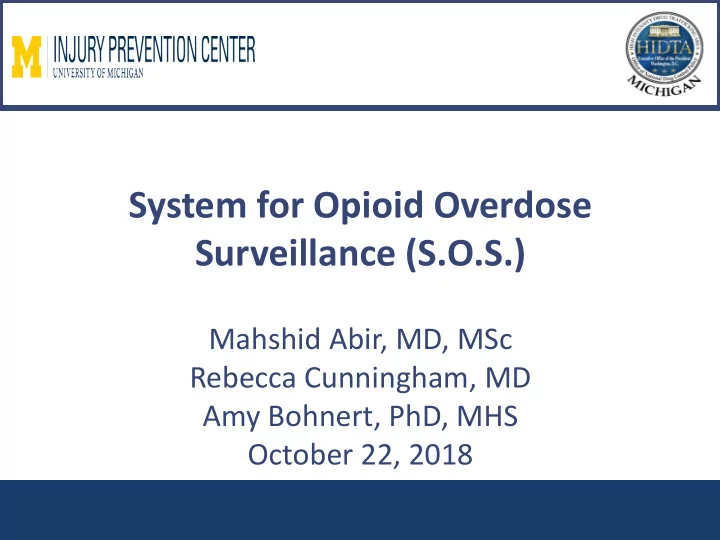

System for Opioid Overdose Surveillance (S.O.S.) Mahshid Abir, MD, MSc Rebecca Cunningham, MD Amy Bohnert, PhD, MHS October 22, 2018
Disclosure • This project is funded by the UM Injury Prevention Center, Michigan HIDTA, and the Michigan Department of Health and Human Services (MDHHS) https://www.cdc.gov/drugoverdose/data/index.html
Opioid Crisis: View from the Frontline
Opioid Overdose: Tip of the Iceberg
Challenges of Surveillance in Michigan • Emergency medical services (EMS) naloxone deployments can be tracked through the Michigan EMS Information System (MI-EMSIS) • Emergency department (ED) data is not centralized – No system currently tracks ED overdoses statewide • Medical examiner (ME) data is not centralized – Current fatal overdose data lags 18 months statewide
System for Opioid Overdose Surveillance (S.O.S.) • Scalable —By using the minimum number of datasets to obtain the most relevant data • Maximizes limited resources —By identifying “hotspots” of fatal and non- fatal overdose • Timely and accurate —By Note: Example of geo-coding hot spots. providing overdose data that is This is NOT real data. not over- or under-counted
Phase 1: Washtenaw County Pilot EMS Huron Valley Ambulance Emergency Departments Michigan Medicine St. Joseph Mercy Health Medical Examiner Washtenaw County
Opioid Overdose Non-fatal Locations Washtenaw County: Jan. 1, 2017-Dec. 31, 2017 Blue = Residence Location Green = Incident Location Hot spots found in zip codes: 48109, 48104, 48198 Data sources: Huron Valley Ambulance, Michigan Medicine, St. Joseph Mercy Health
Opioid Overdose Fatal Locations Washtenaw County: Jan. 1, 2017-Dec. 31, 2017 Red = Incident Location Blue = Resident Location Hot spots found in zip codes: 48109, 48104, 48198 Data sources: Washtenaw County Medical Examiner, Michigan Medicine emergency department, St. Joseph Mercy Health emergency department
S.O.S. Expansion to 3 HIDTA Counties by end of 2018: Washtenaw, Kent, Muskegon • Obtain EMS data through MI-EMSIS database EMS • Partnership with Great Lakes MI-EMSIS Health Connect (GLHC) to obtain real-time ED overdose data from Emergency Standardize Departments & Match the lower peninsula Data HIE Company: Great Lakes Health – Cannot be used for research Connect • Partnership with MDILog to obtain real-time ME overdose data Medical Examiner – Used in 42 of 83 (50%) Michigan MDILog death counties database • Further develop the S.O.S. interface
S.O.S. Interface About page
S.O.S. Interface Emergency Department Opioid Overdose Emergency Department visits by County Michigan Medicine ED, 1/1/2017-10/25/2017
S.O.S. Interface Detail Map: EMS Incident Locations EMS, Emergency Department, and Medical Examiner 1/1/2017-10/25/2017
S.O.S. Interface Detail Map: Fatal Heatmap EMS, Emergency Department, and Medical Examiner 1/1/2017-10/25/2017
S.O.S. Interface Emergency Department
S.O.S. Capabilities • Non-fatal Overdoses – EMS: Update 3 times a week – ED: Update every 24 hours • Fatal Overdoses (ODs) – Update suspected ODs every 24 hours – Confirm ODs after toxicology results are obtained ~90 days later • Linkage of 3 datasets- eliminates over counting of EMS and fatal ED visits • Presents both rates and raw numbers of events • Provides both location of home and location of death for fatal overdoses and non-fatal EMS: allows for tracking of movement • County level data available to the public • Census tract data password protected for key stakeholder access
Next Steps • Continue expanding surveillance to remaining 9 High Intensity Drug Trafficking Areas (HIDTA) countie s • Ultimate goal of statewide surveillance in the next 3 years
Implications • S.O.S. allows both public health to: 1. Continuously follow the size, spread, and trends of non- fatal and fatal overdoses 2. Implement interventions in communities where they are most needed 3. Inform allocation of resources
Recommend
More recommend